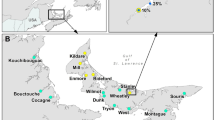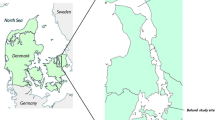Abstract
Surveys were conducted in April and June 1995 to quantify the uptake of dissolved nutrients in a highly turbid estuary (the Humber, United Kingdom) and to determine the factors controlling nutrient uptake rates. A combination of isotope labelling methods were used in conjunction with on-deck incubation techniques to estimate the uptake of dissolved nutrients (PO4 3−, NH4 +, NO3 −, and urea) in surface samples collected from coastal waters. Similarly, isotope labelling and laboratory incubgation techniques were employed to estimate dissolved nitrogen uptake (NH4 +, NO3 −, and urea) in surface samples collected from the estuary mouth. Nutrient uptake rates were at the low end of ranges for coastal and estuarine environments reported in the literature. Concentrations of chlorophyll and the availability of photosynthetically active radiation were identified as potentially important factors controlling the uptake rates of nutrients. Uptake rates of dissolved nitrogen in the Humber mouth appeared to be related to the location of smapling sites. Depletion rates of dissolved nutrients in situ were estimated on the basis of integrated water column nutrient uptake rates and indicated assimilation of up to 16% of nutrients in the entire water column. Estimated depletion rates did not indicate preferential loss of any of the nutrient species investigated.
Similar content being viewed by others
Literature Cited
Berger, W. H. 1988. Global maps of ocean productivity, p. 429–455.In W. H. Berger, V. S. Smetacek, and G. Wefer (eds.), Productivity of the Oceans, Present and Past. Wiley-Interscience. Chichester, United Kingdom.
Billen, G., C. Lancelot, andM. Meybeck. 1991. N, P, and Si retention along the aquatic continuum from land to ocean, p. 19–44.In R. F. C. Mantoura, J.-M. Martin, and R. Wollast (eds.), Ocean Margin Processes in Global Change. John Wiley & Sons, New York.
Brockmann, U. H., R. W. P. M. Laane, andH. Postma. 1990. Cycling of nutrient elements in the North Sea.Netherlands Journal of Sea Research 26:239–264.
Dugdale, R. C. andJ. J. Goering. 1967. Uptake of new and regenerated forms of nitrogen in primary productivity.Limnology and Oceanography 12:196–206.
Fichez, R., T. D. Jickells, andH. M. Edmunds. 1992. Alga blooms in high turbidity, a result of the conflicting consequences of turbulence on nutrient cycling in a shallow water estuary.Estuarine, Coastal and Shelf Science 35:577–592.
Fisher, T. R., P. R. Carlson, andR. T. Barber. 1982. Carbon and nitrogen primary productivity in three North Carolina estuaries.Estuarine, Coastal and Shelf Science 15:621–644.
Grillo, J. F. andJ. Gibson. 1979. Regulation of Pi accumulation in the unicellular cyanobacteriumSynechococcus.Journal of Bacteriology 140:508–517.
Holligan, P. M., T. Aarup, andS. B. Groom. 1989. The North Sea: Satellite colour atlas.Continental Shelf Research 9:667–765.
Joint, I. R. andA. J. Pomroy. 1981. Primary production in a turbid estuary.Estuarine, Coastal and Shelf Science 13:303–316.
Joint, I. R. andR. J. Uncles. 1983. Vertical mixing and its effects on phytoplankton growth in a turbid estuary.Canadian Journal of Fisheries and Aquatic Sciences 40(Supplement 1):221–228.
Joint, I. andA. J. Pomroy. 1993. Phytoplankton biomass and production in the southern North Sea.Marine Ecology Progress Series 99:169–182.
Kirk, J. T. O. 1994. Light and Photosynthesis in Aquatic Ecosystems. Cambridge University Press, Cambridge, England.
MacCarthy, J. J., W. R. Taylor, andJ. L. Taft. 1977. Nitrogenous nutrition of the plankton in the Chesapeake Bay. 1. Nutrient availability and phytoplankton preferences.Limnology and Oceanography 22:996–1011.
Mantoura, R. F. C., J.-M. Martin, andR. Wollast (eds.). 1991. Ocean Margin Processes in Global Change. John Wiley & Sons, New York.
Morris, A. W. 1988. The estuaries of the Humber and the Thames, p. 213–224.In W. Salomons, B. L. Bayne, E. K. Duursma, and U. Forstner (eds.), Pollution of the North Sea: An Assessment. Springer-Verlag, New York.
Mulvenna, P. E. andG. Savage. 1992. A modified manual method for the determination of urea in seawater using diacetyl monoxime reagent.Estuarine, Coastal and Shelf Science 34:429–438.
National Rivers Authority (NRA). 1993. The quality of the Humber estuary 1980–1990. Water Quality Series No. 12, National Rivers Authority, Bristol, England.
Natural Environment Research Council (NERC). 1992. North Sea Project CD-ROM: Oceanographic data collected during the NERC Community Research project 1988–1991. British Oceanographic Data Centre, Proudman Oceanographic Laboratory, Bidston Observatory, Birkenhead, United Kingdom.
Owens, N. J. P. 1988. Rapid and total automation of shipboard.15N analysis: Examples from the North Sea.Journal of Experimental Marine Biology and Ecology 122:163–171.
Owens, N. J.-P. andA. P. Rees. 1989. Determination of nitrogen-15 at sub-microgram levels of nitrogen using automated continuous-flow isotope ratio mass spectrometry.Analyst 114:1655–1657.
Owens, N. J. P., R. F. C. Mantoura, P. H. Burkill, R. J. M. Howland, A. J. Pomroy, andE. M. S. Woodward. 1986. Nutrient cycling studies in Carmarthen Bay: Phytoplankton production, nitrogen assimilation and regeneration.Marine Biology 93:329–342.
Owens, N. J. P., E. M. S. Woodward, J. Aiken, I. E. Bellan, andA. P. Rees. 1990. Primary production and nitrogen assimilation in the North Sea during July 1987.Netherlands Journal of Sea Research 25:143–154.
Parsons, T. R., Y. Maita, andC. M. Lalli. 1984. A Manual of Chemical and Biological Methods for Seawater Analysis. Pergamon Press, Oxford, England.
Redfield, A. C., B. H. Ketchum, andF. A. Richards. 1963. The influence of organisms on the composition of sea water, p. 26–77.In M. N. Hill (ed.), The Sea, Volume 2. Interscience. New York.
Reid, P. C., C. Lancelot, W. W. C. Gieskes, E. Hagmeier, andG. Weichart. 1990. Phytoplankton of the North Sea and its dynamics: A review.Netherlands Journal of Sea Research 26:295–331.
Smetacek, V., U. Bathmann, U.-M. Nöthig, andR. Scharek. 1991. Coastal eutrophication: Causes and consequences, p. 251–279.In R. F. C. Mantoura, J.-M. Martin and R. Wollast (eds.), Ocean Margin Processes in Global Change. John Wiley & Sons, New York.
Walsh, J. J. 1991. Importance of continental margins in the marine biogeochemical cycling of carbon and nitrogen.Nature 350:53–55.
Author information
Authors and Affiliations
Corresponding author
Rights and permissions
About this article
Cite this article
Shaw, P.J., Purdie, D.A., de Frietas, P.S. et al. Nutrient uptake in a highly turbid estuary (the Humber, United Kingdom) and adjacent coastal waters. Estuaries 21, 507–517 (1998). https://doi.org/10.2307/1353290
Received:
Accepted:
Issue Date:
DOI: https://doi.org/10.2307/1353290




